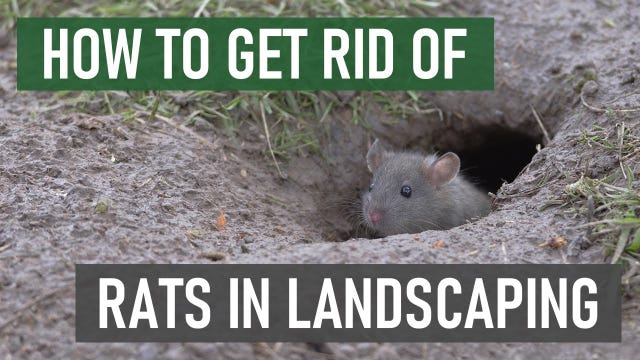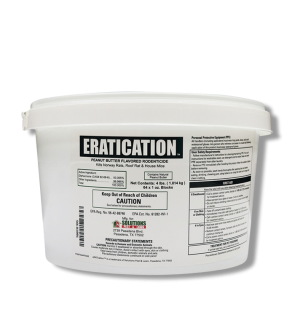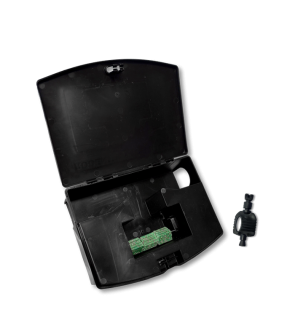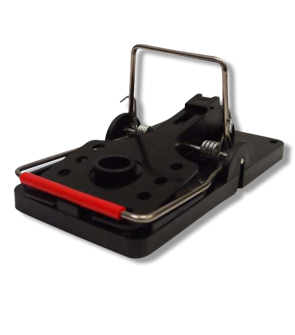Gain access to personalized product screening, the best pricing, rewards, and more!
Most Effective Products
How to Get Rid of Rats in Your Garden or Ornamental Landscape
This page is a general article about any type of rats infesting your home's garden or ornamental landscape. Throughout this page, you will find professional products and tips to guarantee complete rat control.
Spotting a rat in your home is unpleasant for any homeowner, but seeing it outside in your garden and flower beds is just as bad. The loose soil, available food sources, and plentiful hiding places make gardens ideal for any rat species.
With their sharp teeth and claws, rats can gnaw through anything in your garden and cause devastation with frequent burrowing and climbing activities. In addition to eating and tearing down foliage, they will also spread infectious diseases through their prolific urine and waste activities.
When it comes to dealing with rats in and around your cared-for garden and ornamental landscape, using both preventative and control strategies together with our professional quality products will help get rid of these rodents quickly.
Signs of Rats in Gardens and Landscapes

To keep your garden free of rats, it is important to recognize signs of their damage and activity. The different varieties of rodents that invade gardens or ornamental landscapes are the roof rat and Norway rat.
The biggest difference between these two pests in terms of damage is that the Norway rat makes its burrows on the ground, whereas roof rats cause significant damage to plants when they travel and make nests in tree and shrub branches.
Holes and Burrows: Norway Rats burrow in soft soils near reliable food sources such as gardens. They are often found underneath bushes and other types of dense vegetation. These smooth burrows or holes range between 1 and 6 feet deep, 2 to 4 inches in diameter across the entrance, and have loose dirt around the outside from their digging activities. Each burrow will have an entrance, exit, and escape hole.
Runways: Rats are shy, blind pests traveling along a structure's sides to hide and remain safe from predators. Smear marks from the pest's oily, greasy body can be visible on gate posts, fences, steps to the garden, or the exterior of building walls adjacent to the garden or ornamental landscape. In grassy areas, the vegetation will be pushed down until flattened, worn, or dead, creating a noticeable path.
Droppings: Droppings are the most accessible identifier of the presence of rats. Rat droppings look like black-colored grains of rice but are larger in length and broader in width. Norway rat feces will have blunt ends measuring 3/4 inches, while roof rat waste is more pointed on the ends and measures 1/2 inch long. Most likely, high concentrations of their droppings can be found on their runways, along fencing, in hidden areas, around plants, or around where they are feeding and nesting.
Plant Disappear Completely or Partially Overnight: Rats are most active at night, digging underneath the plants in your garden or ornamental landscape to create burrows. During their digging activities, the roots and base of the plant become loose, giving it a slanted or loose appearance, or it will completely fall over and dislodge from the roots.
Plants that grow fruit and vegetables or near your home's foundation can attract rats. These pests deem these plants a reliable food source and possible new nest sites. Rats such as roof rats are the most common pests that climb tree and shrub branches and other types of plants to reach these sites. Their climbing activities or hopping to different parts of the plant causes leaves, stems, and branches to become loose, torn, or destroyed.
Gnawing: Rats tend to gnaw on various surfaces to help maintain the health and size of their teeth. These gnaw marks can be seen on garden doors, fences, garden hoses, fruits, vegetables, plastic plant containers, fallen leaves, and other hard materials made from wood, rubber, vinyl, and low-grade concrete in or near these sites.
How to Keep Rats Out of Your Garden or Landscape
Rats are smell-dependent pests that will scurry away from the smallest hint of your odor on any product used. For this reason, you will need to wear personal protective equipment (PPE) such as gloves before handling or applying any rodent control products.
Rats are most active at night and during dawn and dusk, so you will need to implement these practices before these time frames to prevent them from avoiding treated areas.
Keep in mind that rodent control in gardens and ornamental landscapes can only be done with snap traps such as the Easy Set Rat Trap. All other forms of rodenticide products will need to be done outside these areas.
Keep Garden and Landscape Clean
The first line of defense against rats is to create an unsuitable environment in your garden and ornamental landscape. Rats favor traveling through extended, dense grassy areas alongside structures, such as fences or buildings adjacent to these sites since they feel more protected and hidden from predators.
Keep your garden and ornamental landscape tidy by using a lawn mower around these sites or hand-pulling unwanted vegetation between plants to reduce places for rats to hide or burrow. Your turfgrass around these areas may be mowed when it reaches a height of at least 3 inches. Just be careful not to cut desired foliage with the mower blades.
All fallen plant debris must be picked up to eliminate sheltered areas for the rat to travel underneath or through.
Overgrown plants in your garden and ornamental landscape can be trimmed to prevent rats from climbing and settling in these areas. If fruits and vegetables are ready to be eaten, picking them up as soon as possible would be beneficial to deter rats and reduce their food sources.
Cover Waste and Remove Food Source
All outdoor garbage cans should be secured with a lid and stored away from your home's foundation, garden, and landscape areas. Dispose of fallen fruits, nuts, and rotten fruits regularly in your yard and garden, as any food odors encourage rats to visit your property.
In most landscape areas, homeowners install bird feeders to draw attention to wild birds. However, spilled seeds encourage rats and other pests, like squirrels, to visit these areas and make them their home. Promptly clean up any spilled seeds around the bird feeder and on it to remove the pests' food source.
Take care of any open compost bins used in your yard, which can be a delightful food source for rats. A sealed compost bin is an ideal method to break down waste faster without attracting the attention of pests like rats. Ensure the compost bin has no gaps between the sides and lid and is in open spaces away from other structures so rats do not establish runways near it.
Do not put any strong-smelling items, such as greasy or fatty foods or dairy like cheese, eggs, or meat, in the compost. Install a heavy mesh screen between the soil and the compost bin to prevent rats from burrowing underneath to get into the bin.
If you have outdoor pets, it would be a good idea to dispose of any uneaten cat or dog food in an outdoor sealed trash can. Rats are not fussy eaters, and they will not turn their heads away from a free, easy-to-access meal in your pet's food dish.
Set Snap-Traps Within Tamper-Proof Bait Stations
Once you have carried out these cleanup measures and eliminated competing food sources, rats should be less likely to visit other products being used. If you do find rat burrows in your garden, you will need to use a snap trap within a rodent bait station.
We recommend using the Easy Set Rat Trap placed inside a Solutions Rat and Mouse Bait Station; this reusable snap trap is a durable plastic and steel constructed rat snap trap designed with a 90-degree angle to quickly capture the rat. This product also features an easy-release metal bar to avoid touching the rodent and making unnecessary contact with your fingers.
Setting these traps inside a tamper-proof bait station will prevent contact with people, animals, or non-target animals.
To set and bait this product, you must place bait such as peanut butter mixed with seeds inside the reservoir in the trap's center while wearing gloves.
Press down the upright metal bar until it clicks into place. Once it clicks, your Easy Set Rat Trap will be set and ready to use. Place loaded bait stations with the baited snap traps along any structures the rat would travel along to reach the garden or landscape area, areas where rats have been noticed to visit, and near burrows. Place each station with snap traps at least 15 to 20 feet apart. Do not set any stations in the garden.
Before activating the Easy Set Rat Traps, set them out with bait for 2-3 days in the Solutions Rat and Mouse Bait Station to allow the rats to become comfortable enough to visit the snap trap. Once this time has passed, you can set the snap traps and check on them daily to replenish bait and remove deceased rodents.
Use Baits Near Outdoor Structures
In addition, to snap traps, you will want to use rodenticide bait like Eratication Rodent Bait. Eratication Rodent Bait is a pre-drilled bait block formulated with peanut butter, seeds, and the active ingredient diphacinone .005% to entice and eliminate rats and mice that consume it within 2 to 4 days.
As with most baits, this product must be placed in a tamper-proof bait station, such as the Solutions Rat and Mouse Bait Station.
With a glove-covered hand, unlock the Solutions Rat and Mouse Bait Station with the included key.
Place 4 to 6 Eratication Rodent Bait blocks on the rods inside the station.
Shut the station's lid until it snaps into place, and then place loaded bait stations along walls, such as sheds or the exterior of your home's foundation.
Rats will never go more than 20 feet from their burrow, so place the loaded bait stations at 20 to 40 feet between each station used. We recommend you use multiple stations to increase the chances of these pests approaching baits.
Replace the Eratication Rodent Bait at least once daily to promote strong odors for rats and remove any deceased pests. After setting up traps and baits may take up to 2 weeks to see a noticeable reduction in pest activity. Continue replacing the bait until rat activity has stopped.
Key Takeaways
How to Tell if Rat Burrow is Still Active
- An inactive rat burrow often has leaves, spider webs, or other debris covering or surrounding the entrance. If you are uncertain if a tunnel is still active, barely cover it with plant debris, then check the next day to see if it has moved. If so, this may indicate a rat is actively visiting this site. These inactive burrows should be filled with soil and flattened with your hand or a shovel so rats cannot reuse them.
Where Do Rats Nests in Gardens and Ornamental Landscapes
- Norway rats prefer to burrow or dig holes on the ground near shrubs and underneath dense vegetation. Roof rats rarely burrow and typically build their nests aboveground in trees and areas overgrown with vines, foliage, and shrubbery.
How to Prevent Rats in Gardens and Ornamental Landscapes
- Once rats have been eliminated from your garden and ornamental landscape,, you must continue with various preventative methods to ensure they do not return. Fill inactive burrows and holes with soil so other rodents cannot reuse these areas. Take bird feeders down or replace them with rodent-proof ones to reduce spillage of bird seeds. You must also throw away uneaten pet food, fallen fruits and vegetables, and rotten fruit and vegetables in a sealable outdoor trash can. Without food, rats will not have a reason to stay in your garden or ornamental landscape. Improve the exterior walls of buildings such as sheds by sealing cracks, crevices, and voids with caulk and Copper Mesh to prevent rats from nesting and foraging in these areas near your garden and ornamental landscape. Keep the grass short at 3 inches, hand-pull small weeds between plants, and remove fallen or piled-up plant matter near or in these areas. Periodically move woodpiles and outdoor furniture in your yard to help keep rats away.














